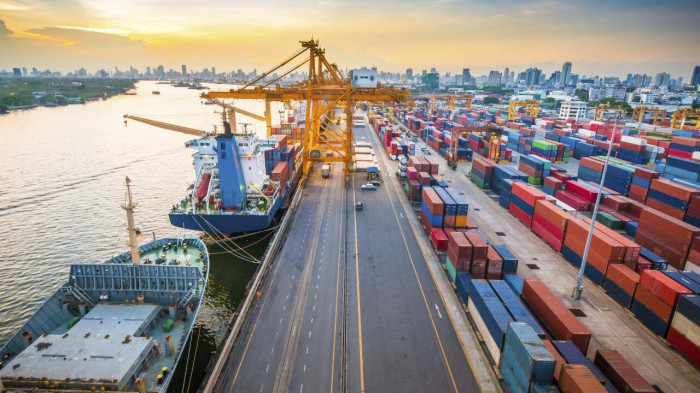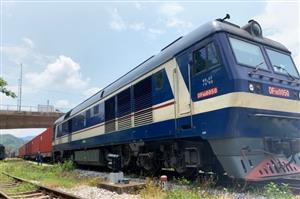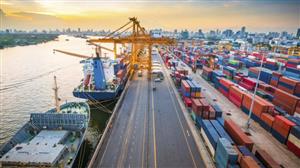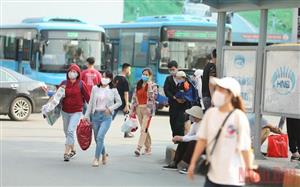Despite the great impact of the COVID-19 epidemic, the total volume of goods through Vietnam's seaports in 2021 will still reach more than 703 million tons, up 2% compared to 2020. In particular, the volume of imported and exported goods International transport exports of Vietnam's shipping fleet achieved a rare growth, increasing by 54% (reaching nearly 5 million tons) compared to 2020. The main commodities transported on the routes: China, Japan Japan, Korea, Southeast Asia and some European routes
Information at the Conference to review the work in 2021 and implement the plan for 2022 of the Vietnam Maritime Administration (Ministry of Transport) on the morning of December 21, Mr. Nguyen Dinh Viet, Deputy Director of the Vietnam Maritime Administration said, In 2021, maritime activities are greatly affected by the COVID-19 epidemic, but the total volume of goods through Vietnam's seaports is still estimated at more than 703 million tons, up 2% compared to 2020.
In which, exports reached more than 184 million tons, up 4%; domestic goods reached nearly 303 million tons, up 5%. Container cargo alone was estimated at nearly 24 million TEUs, up 6% over the same period last year. The total transport volume transported by Vietnam's shipping fleet also prospered during the pandemic, estimated at 156.5 million tons, up 2% compared to 2020.
In which, the container cargo volume of Vietnam's shipping fleet is estimated at more than 3 million TEUs, up 12% over the previous year. The fleet of ships with Vietnamese flags is still taking care of nearly 100% of domestic goods transported by sea, except for some specialized ships such as LPG, bulk cement...
In particular, Mr. Viet informed, the volume of international transport import-export goods transported by Vietnam's shipping fleet also has a rare growth rate, increasing by 54% (reaching nearly 5 million tons) compared to 2020. The main goods are transported on the routes: China, Japan, Korea, Southeast Asia and some European routes.
Recognizing and appreciating the results that officials, employees and employees have achieved in the past difficult year, Deputy Minister of Transport Nguyen Xuan Sang assessed: In the past 20 years, the construction and organization deploying seaport planning is a "characteristic" in maritime management. Thanks to comprehensive planning and flexibility in planning implementation, Vietnam has a synchronous seaport system spanning the whole country.
“In the past, many people thought that we had 'port syndrome', where every local wanted a seaport, causing many fragmented ports. However, I think that thanks to the extensive port system stretching across the country, we have formed an inland coastal transportation network. This network has contributed to reducing pressure on road transport, promoting the advantages of large volume, low cost and environmentally friendly transportation.
Thanks to the breakthrough in seaports, Vietnam has been able to receive the largest 'mother ships' in the world in the past year, we also have long distance shipping routes from gateway ports such as: Lach Huyen, Cai Mep - Thi Vai go to the West and East coasts of the US, Europe... so that Vietnamese goods can be exported directly on shipping routes around the world", Deputy Minister Nguyen Xuan Sang affirmed. determined.
In addition, the effective exploitation of the seaport system has helped Vietnam attract a huge investment from socialization, up to 84% of the total 250,000 billion VND in funding for cargo infrastructure investment. sea in the past 10 years.
"From the achieved results, in the coming period, the State budget will continue to be determined and used to ensure a part of investment in public maritime infrastructure, focusing on Cai Mep - Thi Vai area. , with a focus on Cai Mep Ha, Lach Huyen, Nam Do Son and Tran De ports, the port infrastructure will continue to attract non-budget capital, the task of the management agency is to select investors. the best”, said Deputy Minister Nguyen Xuan Sang.
Regarding institutional building, the Deputy Minister of Transport requested the Vietnam Maritime Administration to urgently review the Maritime Code in the direction of comprehensive revision and renewal, in line with reality and development trends. of the maritime industry, meeting the special requirements of the marine economic development strategy.
"The Maritime Code must be studied and reviewed comprehensively in 2014 to have a basis for proposing amendments by 2025. By 2026, Vietnam will have a new Maritime Code."
In particular, the Deputy Minister noted, in 3 main 'tripod': Investment in construction and operation of seaports - Shipping - Maritime services, seaports are identified as important 'tripod' playing an important role. leading, spreading to the remaining two tripods. Therefore, during the review process, the drafting unit can study and propose to develop a separate Law on Seaports so that this field can be promoted and created a driving force for the development of the maritime economy.

















